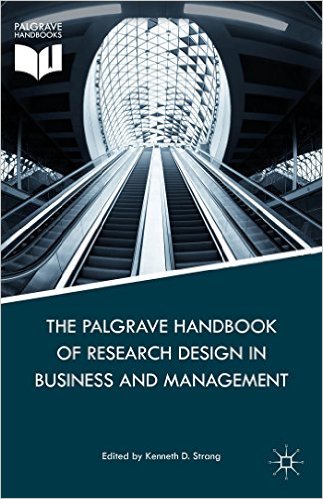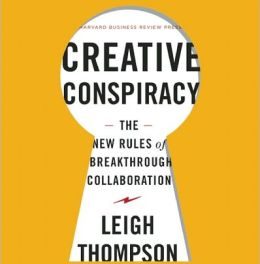 Editor: Kenneth D. Strang, PhD
Editor: Kenneth D. Strang, PhD
Publisher: Palgrave Macmillan – 565 pages
Book Review by: Deekay Daulat
Like any architect who needs a good blue print to get approvals before beginning a construction project, any researcher needs to design a solid plan before starting a research project.
This book helps you, the researcher, business owner or manager learn how to create and use various practical research designs based on existing theory and the latest in empirical best practices. A flawed design will give you bad or unusable data, and faulty results based on such data, just as a structurally unsound building will result from a shaky foundation. So it is best that you begin correctly with a good research design.
This book presents numerous case studies based on real-world situations so learning is easier, more retainable, and quicker, unlike other books on the subject that focus on abstract concepts far removed from practical applications and experience.
The 30 authors of the 28 chapters that constitute this book have diverse cultural backgrounds. They are authors of articles and books, professors, researchers, scholars, and experienced business executives who live and work not only in different parts of the United States, but also in Australia, China, Germany, Hong Kong, India, Singapore, South Korea, Thailand, the United Kingdom, and Vietnam.
The coverage of subjects and topics in this book is as extensive as it is intensive. To get a sort of bird’s eye view of what you will (and will not) find in this book, take a look at Figure 2.1 in chapter 2, Articulating a Research Design Ideology. The best way we can inform you in detail what is in this volume is to give you a broad overview, so here below is what you will find in its Contents pages:
Preliminary Introductions
Preface: What’s Unique for Practitioners
Contributor Biographies
- Part I – Research Design Guidelines
- Why Practitioner-Scholars Need a Research Design Typology
- Articulating a Research Design Ideology
- Developing a Goal-Driven Research Strategy
- Matching a Research Method with Ideology and Strategy
- Selecting Research Techniques with for a Method and Strategy
- Design Issues in Cross-Cultural Research: Suggestions for Researchers
- Establishing Rationale and Significance of Research
- Organizing and Conducting Scholarly Literature Reviews
- Interpreting Findings and Discussing Implications for All Ideologies
- Part II – Positivist Applications
- Implications of Experimental versus Quasi-Experimental Designs
- Structural Equation Modeling: Principles, Processes, and Practices
- Correlation to Logic Regression Illustrated with a Victimization-Sexual Orientation Study
- Survey Method versus Longitudinal Surveys and Observation for Data Collection
- Cross-Sectional Survey and Multiple Correspondence Analysis of Financial Manager Behavior
- Control Variables: Problematic Issues and Best Practices
- Monte Carlo Simulation Using Excel: Case Study in Financial Forecasting
- Part III – Pragmatistic Applications
- Critical Analysis Using Four Case Studies across Industries
- Integrating Multiple Case Studies with a Merger and Acquisition Example
- Iterative-Pragmatic Case Study Method and Comparisons with Other Case Study Method Ideologies
- Action Research Applied with Two Single Case Studies
- Transportation Queue Action Research at an Australian Titanium Dioxide Mining Refinery
- Participant Observation as Ethnography or Ethnography as Participant Observation in Organizational Research
- Constructivist Applications
- Constructivist Grounded Theory Applied to a Culture Study
- Phenomenology Variations from Traditional Approaches to Elderly and Hermeneutic Applications
- Hermeneutic and Eidetic Phenomenology Applied to a Clinical Health-Care Study
- Structure of a Dissertation for a Participatory Phenomenology Design
- Emancipatory Phenomenology Applied to a Child Sex Offender Study
- Final Generalizations and Descriptive Characteristics
- Gaps to Address in Future Research Design Practices
A large number of graphics such as charts and drawings are provided for you in this book alongside discussions in text form. A lot of data is also presented in tabular form. These features in the book help enhance and speed up learning, understanding, recall, and retention.
To get a quick glimpse of what is in a chapter, you can go to the Introduction and Conclusion sections. You will also find very useful lists of supporting materials and sources of additional information at the end of each chapter in the References section.
This is an authoritative but down-to-earth, well documented, extensively researched, highly practical, source of further information, very useful, and all in all, outstanding work on the subject of research design in general, and in particular as it applies to business and management.
Editor:
Kenneth D. Strang, PhD is a senior lecturer and professor at the State University of New York, Plattsburgh at its Queensbury, NY campus. He has over 31 years of combined industry with research experience, several degrees, and certifications along with numerous published studies.
He is the coordinator and a professor in the Bachelor of Science in Business Administration program at his campus. He is also a doctoral supervisor for students at several universities in the United States, Australia and other countries.
He has to his credit, over 150 publications (since 1981) across several disciplines and industries. Prior to becoming a professor, he worked for Blue Cross, IBM, and then as a project management consultant at other large corporations around the world. He created organizations and still serves as CEO/president or a board of directors executive on a few.
Contributors:
Torgeir Aleti, Rodney Alexander, Mark Beaulieu, Linda Brenan, Dae Seok Chai, Creaig A. Dunton, Richard Fuller, John F. Gaski, Jeremy W. Grabbe, Linnaya Graf, Judith Hahn, Joseph F. Hair, Seifedine Kadry, Eun Sook Kim, Sewon Kim, Angeline Lim, Jillian McCarthy, Dang Nguyen, Lukas Parker, Mary Ann Rafoth, Peter John Sandiford, Krittaya Sangboon, Leon Schjoedt, Lars Schweitzer, George Semich, Harm-Jan Steenhuis, Kenneth D. Strong, Edward Sturman, and Nartasaimha Rao Vajjhala







